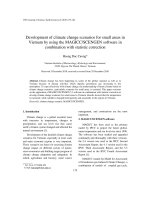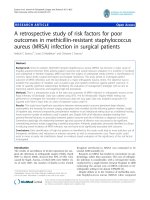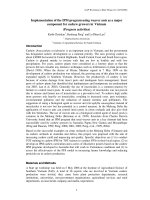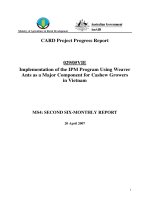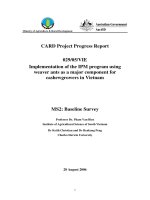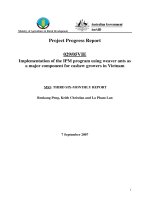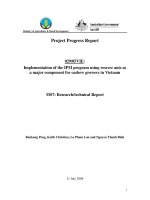Framework of Critical Success Factors for Lean Implementation in Vietnam Manufacturing Enterprises
Bạn đang xem bản rút gọn của tài liệu. Xem và tải ngay bản đầy đủ của tài liệu tại đây (115.43 KB, 9 trang )
VNU Journal of Science: Economics and Business, Vol. 31, No. 5E (2015) 33-41
Framework of Critical Success Factors
for Lean Implementation in Vietnam Manufacturing Enterprises
Nguyễn Đạt Minh1,*, Nguyễn Danh Nguyên1, Lê Anh Tuấn2
1
School of Economics and Management - Hanoi University of Science and Technology,
No. 1 Đại Cồ Việt Road., Hai Bà Trưng Dist., Hanoi, Vietnam
2
Electric Power University, No. 235 Hoàng Quốc Việt Road., Bắc Từ Liêm Dist., Hanoi, Vietnam
Received 25 October 2015
Revised 15 December 2015; Accepted 25 December 2015
Abstract: Lean manufacturing is a popular approach for organizations to improve productivity [1].
Lean manufacturing focuses on the systematic elimination of wastes and non-value added
activities in production. Lean manufacturing was originally introduced by Toyota Motors in the
1950s as a secret weapon to secure advantage over competitors. Although many enterprises
succeed in applying lean manufacturing around the world, less than 20 per cent of them have
achieved and maintained lean activities for an extended time. This research presents critical factors
for constituting the successful implementation of lean manufacturing in Vietnam enterprises. Six
dimensions in a lean manufacturing transformation model are presented in the research,
specifically: (1) Strategic initiatives, (2) Process management, (3) Change management, (4)
Human resource management, (5) Situation management, and (6) External management.
Keywords: Lean manufacturing, critical success factors, manufacturing enterprises.
1. Introduction *
performance enhancements and significantly
improved delivery, quality, flexibility and
manufacturing costs [4].
Globalization and emerging technologies
have enormous impacts on the manufacturing
industry around the world. Lean manufacturing
(LM) will be a standard manufacturing model
in the 21st century [2]. The main strength of LM
is that it is capable of reducing manufacturing
costs through the elimination of all types of
waste. It will guide a company to become a
world-class organization [3]. This approach in
eliminating waste has made a substantial impact
on manufacturing companies resulting in higher
As a result, many companies have saved
millions of dollars in reducing cost via waste
elimination (such as over-production, defects,
over-processing, delays, and inventories…).
Other companies around the world have also
succeeded in LM implementation [5]. However,
not all enterprises can claim to have had the
same benefits. According to Kilpatrick and
Osborne (2006), fewer than twenty percent of
the companies have succeeded in implementing
LM for more than one year [6].
_______
*
Corresponding author. Tel.: 84-972360032
E-mail:
33
34
N.Đ. Minh et al. / VNU Journal of Science: Economics and Business, Vol. 31, No. 5E (2015) 33-41
In Vietnam, LM was introduced after the
1990s as a new approach for organizations in
productivity improvement, cost reduction, and
quality
assurance.
Several
Vietnamese
enterprises have applied LM tools and
techniques and achieved highly encouraging
results, such as Garment No 10 Company,
Fomeco Company, LeGroup Company, and
VPIC1 Company… However, LM in Vietnam
is still a new concept for most organizations. As
mentioned above, the ratio of successful
enterprises in Vietnam is not high, just less than
one percent [7].
These contrasting results make LM
implementation a complex and central process.
Therefore, the critical success factors (CSFs) in
the implementation of LM must be identified.
This research aims to outline the factors that are
perceived as critical for the successful
application of LM.
2. Literature review
2.1. Lean manufacturing
Lean manufacturing is an integrated set of
principles, practices, tools and techniques
designed to address the root causes of
operational underperformance. It is a systematic
approach to eliminate the sources of loss from
entire value streams in order to close the gap
between actual performance and the
requirements of customers and shareholders.
Therefore, the objective of LM is to optimize
cost, quality and delivery, while improving
safety. Accordingly, LM tries to eliminate three
key types of losses in operation: wastes,
variability and inflexibility [8].
The term LM was first introduced in 1990
in the book of “The Machine that Changed the
World” published by Womack and Jones. LM
as a secret weapon is responsible for wastes
elimination and quality improvement, hence
cost reduction within organizations [9].
According to Detty and Yingling (2000), LM is
a comprehensive philosophy for structuring,
operating,
controlling,
managing
and
continuously improving industrial production
systems [10]. Phillips (2004) asserted that the
goal of LM is the reduction of wastes in human
effort, inventory, time to market and
manufacturing space, in order to become highly
responsive to customer demand while producing
world-class quality products in the most efficient
and economical manner. There are seven types of
wastes in LM systems: transportation, inventory,
motion, delays, overproduction, over-processing,
and defects [11].
Shah and Ward (2003) also indicated that
LM is a multi-dimensional approach that
encompasses a wide variety of management
practices, including Just-In-Time, JIDOKA,
Standardized work, Kaizen, team work, cellular
manufacturing and supplier management [12].
Cook and Graser (2001) also maintained that
LM is a broad collection of principles and
practices that can improve corporate
performance [13]. According to Creese (2000),
LM is a manufacturing philosophy that shortens
lead time and reduce costs via eliminating
wastes (MUDA) yet improves quality,
employee skills and job satisfaction [14].
Besides that, Nordin et al (2011) pointed
out that the ultimate goal of LM is to create a
smooth and high quality production to satisfy
the customers’ demand [15].
2.2. Lean success indicators
Many
factors
indicate
that
lean
intervention has been successfully adopted by
Vietnam’s manufacturing organizations. From
N.Đ. Minh et al. / VNU Journal of Science: Economics and Business, Vol. 31, No. 5E (2015) 33-41
the literature study, it is very clear that an
important aim or objective of lean
manufacturing is the continuous and
sustainable elimination of waste resulting in a
decline in lead times, and an increase in
productivity, quality, and on-time delivery.
2.3. Critical success factors
Critical success factors (CSFs) are the
limited number of factors in which satisfactory
results will ensure successful competitive
performance for individuals, departments or
organizations. CSFs are those areas where
“things must go right” for the business to
flourish and attain the manager’s goals [16].
Critical success factors are very important in
ensuring the successful implementation of LM
and to avoid failure risks such as generation of
losses to an organization’s cost, time and
employee’s efforts [17]. The CSFs approach
has been widely adopted and used in different
research fields to determine key factors which
are essential to the success of any program or
technique. For example, Achanga et al (2006)
classified four CSFs of lean in SMEs, namely
leadership and management, skills and
expertise, finance, and a culture of continuous
improvement [18].
2.4. Critical success factors of LM implementation
Although,
many
companies
have
implemented LM tools and techniques, most of
them are faced with challenges. These
challenges could be avoided and overcome by
identifying the CSFs of LM tools. In other
words, there are many CSFs if identified and
well understood that will support the
35
overcoming of these obstacles and difficulties
[19]. Therefore, studying and understanding the
CSFs of LM implementation is very essential.
There are many papers published regarding the
CSFs of LM and productivity improvement
initiatives. Table 1 presents factors as indicated by
different authors in previous researches.
Table 1 shows that there have been
disagreements among the reviewed articles.
Some factors were mentioned in most of the
research (e.g.: top management commitment,
culture change, training, communication…)
while others were found in only one or two of
the researches. This gap could be attributed, in
the researcher’s opinion, to the sparse
theoretical background that underpins the
interpretation of how and why these factors
guarantee successful implementation of the LM
approach, since they were identified through a
revision of the experience of some companies
that have successfully implemented the LM
approach. Therefore, the necessity of
developing a theoretical framework has
emerged, one that accounts for how and why
these critical factors guarantee successful LM
approach implementation. This framework
should also include the critical implementation
factors. This is because it may prove the
validity of this framework to theoretically
interpret the success of the implementation of
the LM approach in each of the previous
studies. Therefore, more probably a new
theoretical model could help interpret the
success of other cases in addition to the case
companies of this current study. Also, such a
framework may help in reducing the variation
among these factors. The following part
discusses these issues further.
36
N.Đ. Minh et al. / VNU Journal of Science: Economics and Business, Vol. 31, No. 5E (2015) 33-41
Table 1: Synthesize critical success factors for LM implementation
No
Critical factors
1
Top management
commitment
2
Clear goals and
objectives
3
Empower
decision maker
4
Financial
capability
5
Time allocation
6
Infrastructure
7
Culture change
8
Behavior change
9
Effective
communication
10
Team work
ability
11
Understand Lean
tools
12
Continuous
improvement
13
Problem solving
ability
14
standardization
15
Employee
involvement
16
Training and
education
17
Reward and
punishment
18
Set up an
evaluation system
(KPI)
19
Project
prioritization
20
Expert consulting
21
Flexible in
implementing
22
Linking Lean to
suppliers
23
Linking Lean to
customers
(1)
(2)
(3)
(4)
(5)
(6)
(7)
(8)
(9)
(10)
(11)
(12)
(13)
(14)
(15)
(16)
(17)
(18)
(19)
(20)
(21)
√
√
√
√
√
√
√
√
√
√
√
√
√
√
√
√
√
√
√
√
√
√
√
√
√
√
√
√
√
√
√
√
√
√
√
√
√
√
√
√
√
√
√
√
√
√
√
√
√
√
√
√
√
√
√
√
√
√
√
√
√
√
√
√
√
√
√
√
√
√
√
√
√
√
√
√
√
√
√
√
√
√
√
√
√
√
√
√
√
√
√
√
√
√
√
√
√
√
√
√
√
√
√
√
√
√
√
√
√
√
√
√
√
√
√
√
Source: Summarized by author.
(1) Achanga et al (2006) [18]; (2) Coronado and Antony (2002) [5]; (3) Yang, P. and Yuyu (2010) [20];
(4) Bakas Ottar et al (2011) [21]; (5) Goutam et al (2012) [22]; (6) Ibrahim Alhuraish et al (2014) [23];
(7) Rose et al (2014( [24]; (8) Kumar, M. et al (2015) [25]; (9) Tack-Wei Leong et al (2012) [26];
(10) Alaskari et al (2012) [27]; (11) Assrar Sabry (2014) [28]; (12) Fiona (2006) [29];
(13) Roslina et al (2011) [30]; (14) Mehmet Tolga Taner (2013) [31];
(15) Womack and Jones (1990) [9]; (16) Womack and Jones(2003) [1];
(17) Liker, J. K (2004) [32]; (18) Kumar, R. et al (2009) [33];
(19) Denis, P (2007) [34]; (20) Al Sarif (2011) [35];
(21) John Shook (2015) [36].
3. Research framework
In order to develop a theoretical framework
that fulfills the aforementioned necessity, this
researcher has looked into the literature that
theoretically tackles the success of the LM
approach. The researcher has found an attempt
within the literature that may fulfill this necessity.
This attempt was made by John Shook (2015),
who explains the success of the transformation of
the LM approach for enterprises [36]. In his
transformation model, John Shook offered six key
questions for lean transformation:
1. What are the leadership behavior
and management systems that are required to
support this new way of working?
2. What is the work that needs to be done?
3. What basic thinking, mindset or
assumptions comprise the existing culture, and
drive this transformation?
4. How can we start the work, and what
situation problem do we need to address?
5. What employee involvement is required
and how can we motivate our people?
6. What are the external factors that impact
the work?
To answer the questions of lean
transformation according to John Shook (2015),
a framework will be developed for this
research, as shown in Figure 1.
N.Đ. Minh et al. / VNU Journal of Science: Economics and Business, Vol. 31, No. 5E (2015) 33-41
4. Research methodology
A qualitative method was conducted for
this research. It produced findings without the
use
of
statistical
procedures
[37].
Furthermore,
the
qualitative
research
provided insights and understanding “how”
and “why” the factors affect the success of
the LM implementation [38].
Since qualitative method was chosen for
this research, a combination of techniques for
collecting data was employed. It comprised a
literature review, observations of companies’
practices, and interviewing key persons relating
to LM implementation. The literature review was
conducted extensively at the initial stages of the
research, demonstrating the existence of gaps in
terms of knowledge. The review did not provide
sufficient information of the issues that affect
companies’ successful implementation of LM.
Therefore, there was a need for further research
within the existing companies that had
implemented the lean concept previously. The
idea behind this move was to investigate further,
so as to determine such factors which are deemed
critical for lean implementation.
preparation of the interviewing process.
Personal interviews were conducted through
semi-structured questionnaires. They involved a
number of key personnel in the companies that
include the general workforce of the concerned
companies involved in lean projects.
In order to find out the perspectives of
companies on the factors which are critical for
LM, a number of questions were tailored to
enable the extraction of ideas that give a true
reflection of the interviewee’s perception of
these factors. Preparing a number of questions
that embodied a company’s definition of LM
and whether that company had implemented
lean manufacturing before. For example, the
key questions in the semi-structured
questionnaires were:
The data was collected from three lean
manufacturing projects which have been
implemented in companies. Main techniques
used for data collection included participants’
observations and personal interviews. The
information was then analyzed and used for the
- What is your definition of LM?
- What has motivated the company to
implement LM?
- How many people are involved in the
exercise?
- What training if any, do the staff
undertake?
- What are the difficulties and how did your
team overcome them?
- What are the direct and indirect resources
involved in the implementation of LM?
- What are the critical factors for successful
implementation of LM? Why?
f
External management
Situation management
Process management
37
Strategic initiatives
Change management
Human resource
management
Lean success
Figure 1: Research framework.
Source: Adapted from John Shook for this study, 2015.
38
N.Đ. Minh et al. / VNU Journal of Science: Economics and Business, Vol. 31, No. 5E (2015) 33-41
5. Research results
5.1. Results background
A profile of three Lean projects and
interviewees implemented in different cases is
shown in Tables 2 and 3.
5.2. Success factors for LM implementation
Strategy initiatives: LM application
typically begins with strategic initiatives from a
senior management team. The most important
factor is top management commitment and
involvement. Top management commitment is
considered in this company as the most
important factor to initiate an LM approach.
Almost all interviewees insisted that top
management commitment is necessary for the
successful implementation of the LM approach,
“… without this commitment, LM will not
continue in any organization”. In addition, there
is a link between a top manager’s acceptance
and his support. So, the top manager said “they
need to say yes, it is okay, and we are going to
support people doing this”. Similarly, some
interviewees said: “We need to have top
management’s support” and “You must have a
commitment right from the top of the company,
from the managing director down to everyone”.
This reflects the claim Achanga et al. (2006)
make that says the implementation of LM is
often driven by the senior leadership.
Organizations that are not able to secure a
mandate from senior leadership will have a lot
of difficulties when implementing LM.
Table 2: Lean project profile
No
Project, Kaizen
Duration
Scope
Status
Result
1
Production efficiency
6 months
Company
Success
Increase efficiency 79% to 85%
improvement (Case 1)
2
Inventory reduction (Case 2)
3 months
Company
Success
Reduce 94% of stock
3
Layout optimization (Case 3)
3 months
Company
Success
Reduce 38% space, 42% moving time
Table 3: Number of interviewees participated for study
No
1
Project, Kaizen
Top management
Middle management
Front line employee
Production efficiency
1- DGM
2- MA, GL
1- TL
improvement (Case 1)
2
Inventory reduction (Case 2)
1- DGM
2- MA, AM
1- SL
3
Layout optimization (Case 3)
2- DGM
1- MA
X
Note: DGM: Deputy General Manager, MA: Manager, AM: Assistant Manager,
GL: Group Leader, TL: Team Leader, SL: Sub-leader.
Source: Summarized by author.
d
Change management: Change management
involves effectively balancing forces in favor of
a change over forces of resistance.
Organizations, groups, and individuals resist
changes that they perceive would threaten them.
It was suggested that corporate transformation
requires a general dissatisfaction with the status
quo by employees who have to change
N.Đ. Minh et al. / VNU Journal of Science: Economics and Business, Vol. 31, No. 5E (2015) 33-41
(i.e. have a readiness to change), have a vision of
the future, and where there is a well-managed
change process. Revolutionary and evolutionary
tactics for accomplishing change depend on the
communication about the change and nature of
the leadership. Thus, the pattern of change,
management’s readiness to change (i.e. being
committed to it, participating in the process, or
being resistant to it), the scope of the change, and
the management of the change, are the key
constructs in practicing change management.
Process management: Process management
is defined as a set of concepts and practices
aimed at better stewardship of business
processes. Successful process management uses
process measurement (e.g.: metrics, information
capture, feedback loops…), tools and
techniques and documentation (flow chart
analysis, fishbone analysis…). Evidence also
supports the use of team-based structures both
for implementing the project and for designing
the new processes. The companies in this study
used successful formal techniques and process
metrics for process management. These
included: just in time, one piece flow, standard
work, Kanban, Poka-yoke, and leveling.
Human resource management: Results
from this study show that training and
education is critical to ensure the success of LM
implementation. Training programs should be
available to all employees working at different
managerial levels. They should be available to
manufacturing and non-manufacturing groups
as well as to managers and workers, leaders and
followers. This widespread availability will
help to reduce knowledge gaps among the
managerial levels. As training programs are
suggested to be made available for all
employees, and because there are different
levels of understanding, responsibilities and
qualifications, there are three types of programs
recommended. Namely, introductory courses,
39
lean tools program, and math and statistics
courses. This variety is elaborated further in the
following part.
Situation management: As LM is a project
driven methodology, it is essential to prioritize
projects which provide maximum financial
benefits to the organization. The projects are
selected in such a way that they are closely tied
to the business goals or objectives of the
organization. Therefore, every project should be
selected so that it will help to improve
competitive advantage, business profitability,
and process cycle time. In a LM project, we
have to answer an important question: “What
problems are we trying to solve?” There are
many criteria for project selection that try to
measure the factors as described. To select a
LM implementation project, we can use
SMART goal method: Specific, Measurable,
Achievable, Realistic, Time specific.
External management: Suppliers support is a
critical factor for the successful implementation of
LM. Companies need to share lean activities
with the suppliers, who have a direct
participation in the company’s manufacturing
deliveries. The traditional approach is to have
different suppliers in order to maintain reduced
costs, however under LM, one way to reduce
cost is to have few suppliers and help suppliers
optimize all activities in manufacturing and
delivery. This is called the “pull system”.
Similarly, LM should begin and end with the
customers. Projects should begin with the
determination of customer requirements. It is
essential to set project goals based on reducing
the gap between the company’s expected and
actual performance, especially in term of
delivery time, reliability and customer
satisfaction. The understanding of markets,
operations, and creativity to maximize value
and performance are the core elements of the
LM approach.
40
N.Đ. Minh et al. / VNU Journal of Science: Economics and Business, Vol. 31, No. 5E (2015) 33-41
6. Conclusions
This research describes the realization of
CSFs
determining
the
successful
implementation of LM in Vietnamese
manufacturing enterprises. The framework of
CSFs provides useful insights for the
enhancement of the critical decision-making
process that are needed for the strategy for LM
application in organizations. In order to achieve
the full potential of LM applications, it is
important to take these factors into
consideration. If any of these ingredients are
missing during the implementation of LM
projects, it would then be the difference
between a successful implementation and a
complete waste of effort, time and money.
From this study, it is observed that the CSFs
have positive impacts on different categories of
performance, such as productivity, quality,
delivery, and cost. Furthermore, different CSFs
show
different
impacts
on
different
performance criteria in different cases.
Although this research produced useful
information and was conducted with a
systematic process, there were several
limitations. This study was conducted in limited
cases through three LM projects. In companies,
people are not very willing to provide useful
and timely information and data for exploration.
The next stage of the research is needed to
deeply evaluate each factor in Vietnamese
manufacturing enterprises to understand their
level of importance. Future studies will also
make an attempt to compare the difference
ranking of the CSFs in various companies.
[4]
[5]
[6]
[7]
[8]
[9]
[10]
[11]
[12]
[13]
[14]
[15]
References
[1] Womack, J. P., Jones, D. T. & Roos, D., Lean
Thinking: Banish Waste and Creat Wealth in
Your Corporation, Simon & Shuster Inc.
[2] Rinehart, J., C. Huxley & D. Robertson, Just
another Car Factory? Lean Production and its
Contents, Harvard Bus. Rev, 57(2) (1997) 81.
[3] Papadopoulu, T. C. & Ozbayrak, M., Leanness:
Experiences from the Journey to Date, Journal of
[16]
[17]
[18]
Manufacturing Techology Management, 16(7),
(2005) 784.
Fullerton, R. R. & C. S. McWatters, The
Production Performance Benefits from JIT
Implementation, J. Oper. Manag, 1 (2001) 81.
Coronado, R. B., & Antony, J., Critical Success
Factors for the Successful Implementation of Six
Sigma Projects in Organizations, The TQM
Magazine, 14(2) (2002) 92.
Jerry Kilpatrick & Robert Osborne, The
R(E)volution of Lean, Business Breakthroughs
Inc., 2006.
Minh, N. D., Lean Management Application in
Vietnam SMEs, Journal of Science - Vietnam
National University, 1 (2014) 63.
Drew, J et al., Journey to Lean - Making
Operational Change Stick, Hampshire: Pallgrave
Macmillan, 2004.
Womack, J. P., Jones, D. T. & Roos, D., The
Machine that Changed the World, New York:
Macmillan, 1990.
Detty, R. B. & Yingling, J. C., Quantifying the
Benefits of Conversion to Lean Manufacturing
with Discrete Event Simulation: A Case Study,
International Journal of Production Research,
38(2) (2000) 429.
Phillips, T., The Production System Design
Laboratory (PSD), Retrieved October 1, 2004,
from edu.
Shah, R. & Ward, P. T., Lean Manufacturing:
Context, Practice Bundles and Performance,
Journal of Operations Management, 21
(2003) 129.
Cook, C. R. & Graser, J. C., The Effects of Lean
Manufacturing. Santa Monica, CA: RAND
Publishers, 2001.
Creese, R. C., Cost Management in Lean
Manufacturing Enterprises, West Virginia
University, Morgantown, WV, 2000.
Nordin, N., Deros, B. M. & Wahab, D. A., Lean
Manufacturing Implementation in Malaysian
Automotive Industry: An Exploratory Study,
Operations and Supply Chain Management, 4(1)
(2011) 21.
Rockhart, J. F., Chief Executives Define their
own Data Needs, Harvard Business Review,
57.2, 1979.
Hamid, R. A., Factor Influencing the Success of
Lean Services Implementation: Conceptual
Framework, 2011.
Achanga, P., Shehab, E., Roy, R., & Nelder, G.,
Critical
Success
Factors
for
Lean
Implementation within SMEs. Journal of
N.Đ. Minh et al. / VNU Journal of Science: Economics and Business, Vol. 31, No. 5E (2015) 33-41
[19]
[20]
[21]
[22]
[23]
[24]
[25]
[26]
[27]
Manufacturing Technology Management, 17(4),
(2006) 460.
Skaf K. M., Application of Lean Techniques for
the Service Industry: A Case Study. M.S.,
Southern Ilinois University at Cabondale, 104,
(2007) 1446981.
Yang & Yuyu, The Barriers to SMEs’
Implementation of Lean Production and
Countermeasures - Based on SMEs in Wenzhou.
International Journal of Innovation, Management
and Technology, 1(2) (2010) 220.
Bakås, O., Govaert, T., Landeghem, V., &
Hendrik., Challenges and Success Factors for
Implementation of Lean Manufacturing in
European SMEs, Norwegian University of Science
and Technology, Trondheim, Norway, 2011.
Goutam Kundu & Murali Manohar, B., Critical
Success Factors for Implementing LEAN
Practices in it Support Services, International
Journal for Quality Research, 6(4) (2012) 301.
Ibrahim Alhuraish et al., Key Success Factors of
Implementing Lean Manufacturing and Six
Sigma, Proceeding of 17th Toulon-Verona
International Conference, Liverpool John
Moores University, 2014.
Rose, A. N., Deros, B.M. & Rahman, M. N.,
Critical Success Factors for Implementing Lean
Manufacturing in Malaysian Automotive
Industry. Research Journal of Applied Sciences,
Engineering and Technology, 8(10) (2014) 1191.
Kumar, R., Rajesh, K., Shankar, R (2015).,
Critical Success Factors for Implementation of
Supply Chain Management in Indian Small and
Medium Enterprises and Their Impact on
Performance. IIMB Management Review, 27
(2015) 92.
Tack-Wei Leong et al., Critical Success Factors
of Six Sigma in Original Equipment
Manufacturer
Company
in
Malaysia.
International Journal of Synergy and Research,
1(1) (2012) 7.
Alaskari, O., Ahmad, M., Dhafr, N., & PinedoCuenca, R., Critical Successful Factors (CSFs)
for Successful Implementation of Lean Tools
[28]
[29]
[30]
[31]
[32]
[33]
[34]
[35]
[36]
[37]
[38]
41
and ERP Systems. Proceedings of the World
Congress on Engineering, 3, London, 2012.
Sabry, A., Factors Critical to the Success of SixSigma Quality Program and their Influence on
Performance Indicators in some of Lebanese
Hospitals, Arab Econimic & Business Journal, 9,
(2014) 93.
Fiona, F. & Santiago, D., Critical Success
Factors for ERP Implementation and Upgrade,
Journal of Computer Information Systems
(Special Issue) (2006) 99.
Roslina Ab Wahid & James Corner, Critical
Success Factors and Imporvement in ISO 9000
Maintenance, Business Management Quarterly
Review, 2(2) (2011) 1.
Mehmet Tolga Taner., Critical Success Factors
for Six Sigma Implementation in Large-scale
Turkish Construction Companies, International
Review of Management and Marketing, 3(4)
(2013) 212.
Liker, K., The Toyota Way: 14 Management
Principles from the World’s Greatest
Manufacturer. McGraw-Hill.
Kumar, M., Antony, J. & Douglas, A., Does Size
Matter for Six Sigma Implementation? Findings
from the Survey in UK SMEs, TQM Journal,
21(6) (2009) 623.
Denis, P., Lean Production Simplified 2nd
edition. Productivity Press, New York, (2007).
Sharif, A. A., Exploring the Critical Factors of
the Successful Implementation of Six Sigma
Approach: A Case Study of Ducab, UAE,
Bournemouth University, 2011.
Shook, J. (2015), Lean Transformation Model,
Lean
Enterprise
Institute,
/>Framework.cfm.
Neuman, W. L., Social Research Methods Qualitative and Quantitative Approache, Ally
and Bacon, New York, 1997.
Perry, C., Processes of a Case Study
Methodology for Postgraduate Research in
Marketing, European Journal of Marketing,
32(9) (1998) 785.
